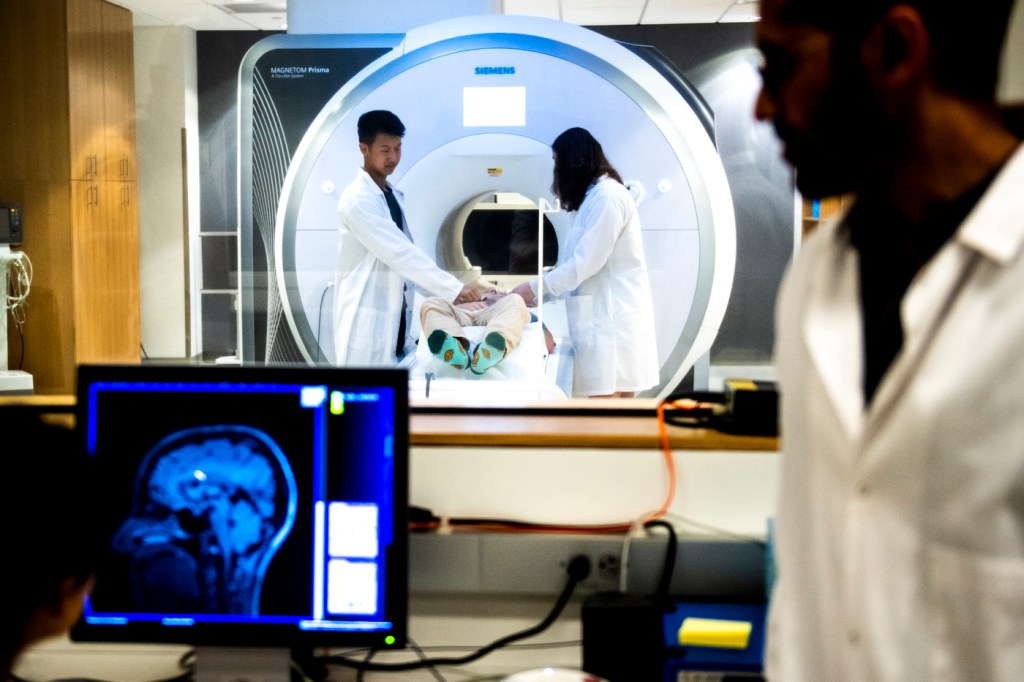Afraid of spiders? Heights? Public speaking? They activate different parts of the brain, Northeastern research finds
A new paper from Northeastern University psychology professor Ajay Satpute’s lab upends previous understandings of how fear works in the mind.

What scares you the most?
Maybe it’s teetering precariously on the ledge of a skyscraper; perhaps it’s a giant, hairy tarantula crawling across your laptop keyboard. Maybe it’s giving a wedding toast and telling a joke that makes nobody laugh.
For a long time, the prevailing research assumed that the responses to these three scenarios occurred similarly within the brain.
“There’s this story that we’ve had in the literature that the brain regions that predict fear are things like the amygdala, or the orbital frontal cortex area, or the brainstem,” says Ajay Satpute, an associate professor of psychology at Northeastern University. “Those are thought to be part of a so-called ‘fear circuit’ that’s been a very dominant model in neuroscience for decades.”
Earlier this month, Satpute and his collaborators released new research that undermines that persistent model. In a study published in the academic journal J.Neurosci, the researchers used MRI scans to observe brain activity when confronted with three distinctive scenarios meant to evoke different types of fear: fear of heights, fear of spiders, and fear of “social threats” (public speaking, confrontations with police).

And contrary to the prevailing scientific wisdom, the neural response to each type of scenario activated different areas of the brain — rather than following a single pattern.
“Much of the debate on the nature of emotion concerns the uniformity or heterogeneity of representation for particular emotion categories,” the study reads. “We show that the overwhelming majority of brain regions that predict fear only do so for certain situations. These findings carry implications for the generalization of findings on fear across species, translational models of fear and anxiety, and developing neural signatures of fear.”
The researchers wanted to test assumptions about how fear works in the brain because in neuroscience, AI and machine learning are increasingly being used to develop models that can predict particular emotions based on patterns of brain activity.
“Most of those approaches assume that there is a single pattern that underlies the brain behavior relationship: there’s a single pattern that predicts disgust. There’s a single pattern that predicts anger,” Satpute says. “Well, if that’s true, then such a pattern should be apparent for different varieties of fear.”
To test this, the study asked 21 participants to fill out surveys about things that scared them, then monitored their brain activity in an MRI while they watched videos depicting first-person viewpoints of distinct, frightening scenarios — looking down steep ledges on a hike; giving a public talk; being approached by a big hairy spider.
“We tried to find really scary videos of spiders,” says Satpute, who is a little freaked out by them himself. “Because I don’t want a neural predictive model that ‘says you’re looking at a spider.’ I want a neural predictive model that says ‘you’re experiencing fear.’”
Featured Posts
After each video participants self-rated their levels of fear, valence (the degree to which an experience is pleasant or unpleasant) and arousal on a questionnaire.
While based on a small sample size, the study revealed two things: Fear responses happened across a wider range of brain regions than expected. But not all brain regions responded across all three situations.“The amygdala, for instance, seemed to carry information that predicted fear during the heights context, but not some of the other contexts,” Satpute notes. “We’re not seeing these so-called ‘classic threat areas’ involved in being predictive of fear across situations.”
The experiment is part of a collection of studies from Satpute’s lab that investigate the bodily mechanisms of fear, furthering the concept that not all fear is the same. In 2021, the group released a study that examined autonomic responses to distinctive scary scenarios — measuring things like sweat and cardiac output. There too, different fears — heights, being chased by police — manifested differently.
In future studies, Satpute hopes to confirm the findings with a larger sample size, getting a closer look at how demographic factors like gender and age might play a part. He says results like this, while preliminary, could play a part in how fear and anxiety-related disorders are treated.
“When we look at the brain and the neural correlates of fear, part of the reason we want to understand is so we can intervene on it,” he says. “Our findings suggest the interventions might need to also be tailored to the person and situation.”
This could affect behavior-based therapies, but also, much further down the line, pharmacological ones.
“Drug-based therapies that target a particular circuit do work, but only for about fiftyish percent of people,” Satpute says. “It’s not really clear why. Our research offers at least some explanation — the brain regions that are going to matter for any emotional experience are going to vary by the person and situation. If you focus only on what’s common, you ignore so much.”











